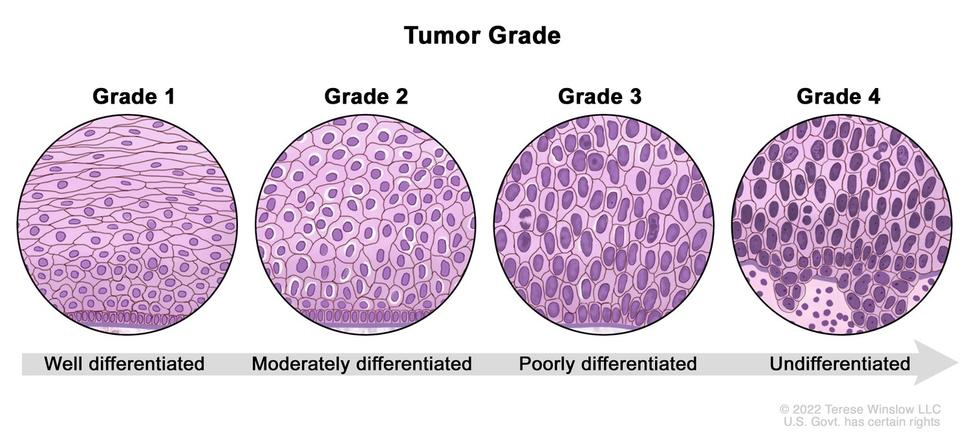How tumor grade is determined
In most cases, doctors need to study a sample of tissue from the tumor to decide if it is cancer and, if it is, its grade. They obtain this tissue by doing a biopsy, a procedure in which they remove all or part of the tumor. A specialist called a pathologist determines the grade of your tumor by studying samples from the biopsy under a microscope. The pathologist describes the findings in a pathology report, which also contains other details about your diagnosis.
Cells that look more normal might be called well-differentiated in the pathology report. And cells that look less normal might be called poorly differentiated or undifferentiated. Based on these and other features of how cells look under the microscope, the pathologist will assign a number to describe the grade.
Different factors are used to decide the grade of different cancers. To learn about the factors that go into deciding the grade of your cancer, find your type of cancer in the PDQ® cancer treatment summaries for adult and childhood cancers.
How tumor grade is described
Systems for describing tumor grade can differ depending on the type of cancer. But most tumors are graded as X, 1, 2, 3, or 4.
- Grade X: Grade cannot be assessed (undetermined grade)
- Grade 1: Well differentiated (low grade)
- Grade 2: Moderately differentiated (intermediate grade)
- Grade 3: Poorly differentiated (high grade)
- Grade 4: Undifferentiated (high grade)
In grade 1 tumors, the cells look close to normal. The higher the number, the more abnormal the cells look. Grade 4 tumors look most abnormal.
To learn more about the system that describes tumor grade for your cancer, see the PDQ® cancer treatment summaries for adult and childhood cancers.
How tumor grade affects your treatment options
Your doctor uses tumor grade and other factors about your cancer to form a treatment plan and in some cases, to estimate your prognosis. Prognosis is an estimate of how the disease will likely go for you. Other factors that go into deciding on a treatment plan include cancer stage, genetic features of the tumor, your age, and your general health. Since a high-grade cancer may grow and spread more quickly, it may require more aggressive treatment right away.
To learn about treatment for your cancer, see the PDQ® cancer treatment summaries for adult and childhood cancers for your type of cancer.

